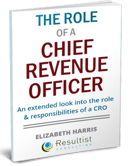
Sitting through a tense meeting where finance and sales are positioned on opposite side of the table engaged in conflict is as iconic in corporate America as a row of cubicles. In fact, for all levels of managers and executives, serving time in battle during these situations for their respective teams is essentially a rite of passage.
In these all too common scenarios, both sides often emerge worse for the wear instead of uniting to drive business growth. The result is a corporate landscape where revenue potential remains unfulfilled and employee satisfaction suffers. Organizational stagnation and, ultimately, demise can quickly follow when conflict breeds.
To attain sustainable business profitability, the issue of clashing CFO and CRO perspectives needs to be addressed and the entire premise of assigning roles needs to be examined.
Clashing Perspectives
Revenue ownership is at the core of the conflict between finance and sales. While finance and accounting teams believe that they own the numbers in their entirety, sales and marketing teams avow that the numbers would not exist without their contribution. These differing points of view cause friction over who gets to make important decisions and who is culpable when the numbers fall short of expectations. The result is a veritable turf war to assert professional dominance, defend decision-making, advocate for potential profit-driving activities, and pass the blame for lackluster performance.
However, in these scenarios, neither team wins. Management at all levels and the overall organization suffers. So, while most internal conflict resolution typically focuses on which team should win in which scenario, a productive conversation should examine how the fight can be abandoned all together.
Dual Function
A common solution for ending the conflict is to merge roles – making the CFO and CRO positions a unified dual position. The argument for this approach is to align points of view under one executive that will oversee finance/accounting and sales/marketing functions for better strategic positioning.
Intuitively, trusting one individual to uphold the interests of two roles should reduce the in-fighting. However, in practice, transforming the CFO into the CRO tends to push the conflict further down in the organization, resulting in power struggles among lower-level management rather than executive-level management.
CFO and CRO Parity
Handling different roles requires that CFOs and CROs have different skillsets and personalities. While a CFO may have a background in finance or accounting, a CRO typically has a sales or marketing bent. These varied backgrounds provide different experience matrices for top-level professionals to utilize.
Forbes explains that a successful CFO should be a:
- Value chain expert
- Hands-on business leader
- Collaboration pioneer
- Advocate of long-term growth
- Metrics-focused business driver
Contrast that to an ideal CRO as someone who is a:
- Revenue strategy communicator
- Data-driven accountability partner
- New market pioneer
- Sales and marketing arbiter
- Results-focused planner
- Seasoned C-Suite Executive
- Team Builder
Therefore, an individual who is well-suited to assume one role, may not necessarily thrive in the other. Equipping a single individual to succeed in both roles is often less successful than bringing in two different people who can leverage their unique strengths to bring the most to the position.
However, while the roles and the people themselves may be different, the positions are of equal importance. Integrating both positions into an organization’s executive structure is an important piece for driving sustainable revenue.
Necessity or Luxury
While some organizations choose to group CFO and CRO roles into one position to reduce friction, others doubt the need for a CRO altogether. In these organizations, a Chief Marketing Officer, Chief Sales Officer, or Chief Development Officer assumes the role of overseeing revenue driving activities. However, this strategy fails to address the operational need for an individual to oversee sales, marketing, and business development activities as a whole, instead of within their individual silos.
This growth-versatile rudiment is what has led the CRO to be named ”Silicon Valley’s hottest new career.” But SaaS companies are not the only ones adopting CROs. Organizations like Bloq, CBS, DocuSign, Eventbrite, Marketo, and Rackspace have CROs successfully controlling their revenue-generating activities as well.
Companies that omit the CRO position from their C-suite roster effectively roll these functions up to the CFO unintentionally. The result is a de facto CFO and CRO merge. However, unlike a formal mingling of the two roles, choosing to ignore the need for a CRO can also result in cutting-edge revenue prioritization taking a backseat to more traditional organizational financial management.
The Power in a Name
Organizations that do not understand the difference between a CFO and CRO can be led astray when trying to merge these roles.
The popular quote from William Shakespeare’s Romeo and Juliet reads, “A rose by any other name would smell as sweet.” However, the CFO and CRO distinctions are not simply a difference in naming convention. They embody fundamentally different approaches to accomplishing similar functions. Understanding these dissimilarities is the key to getting the most out of both roles.
CFOs handle the full array of financial aspects for the business keeping the idea of revenue in mind as an end goal. However, CROs drive revenue as their only objective through sales, marketing, and partnership management. While the outcome may be the same, the path to getting there is very different.
Furthermore, CFOs often play the role of mediator between conflicting finance and sales/marketing teams, whereas the CRO acts as the coach tasked with rallying everyone behind a single goal to beat the competition.
Fueling Business Growth
Though it may not seem like it, conflict is really a conversation. While it may be a less productive dialog than that of a peaceful collaboration, it conveys vital information needed to understand all point of views represented. The key is unpacking the truths that are hidden inside what may come across as aggressive or offensive communications.
The solution lies in a commitment to collaboration between the two fundamentally different approaches – a CRO approaches business from the standpoint of growth, “Let’s do more.” While a CFO tends to approach business from a perspective geared toward increasing efficiencies or expense reduction.
Understanding how to get the most out of the communication to fuel growth is the single most important consideration when it comes to the role of the CRO and the CFO to resolve conflicts. Bringing in an executive leadership consultant is a proven strategy for unifying an organization to create success. A trusted third-party professional can provide the context and experience needed to leverage conflict for the sake of the overall business.
The Role of a Chief Revenue Officer
 This ebook will help you study and define the role of a Chief Revenue Officer. A CRO is more than just a glorified VP of Sales. With a more thorough understanding of the CRO role you will be better prepared to develop the company’s business model, ensuring alignment across all departments, and achieving the company's goals and vision with greater speed and agility.
This ebook will help you study and define the role of a Chief Revenue Officer. A CRO is more than just a glorified VP of Sales. With a more thorough understanding of the CRO role you will be better prepared to develop the company’s business model, ensuring alignment across all departments, and achieving the company's goals and vision with greater speed and agility.
